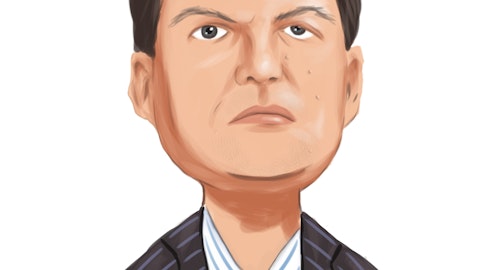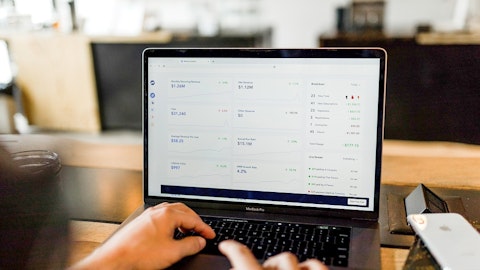Kristine Juster: Greg, as we struck to grow Poppin going forward, one of the things that you’ll see is we’re kind of channel agnostic as to where the order goes to. So when you think about the end user, they’re the ones who will make the decision as to whether they want to buy it through the dealer, which is the KI selling organization or the Poppin direct model. And so we’re doing all that channel work right now. But that brand and that opportunity will start to become fully integrated throughout Kimball International.
Operator: . Our next question comes from Rexford Henderson with Water Tower Research.
Rexford Henderson: I had a couple of questions. First of all, congratulations on the really strong gross margin performance. You gave some components of that gross margin improvement. So we can kind of understand where that goes in the future. Can you kind of break out how much of those gross margin improvement came from each 1 of the 3 components. Can you kind of give us some color on how you achieve that where that’s going into the future?
Timothy Wolfe: Sure, Rex. I think if I was to put in and we can talk a little bit about how the specifics, but in sort of order of magnitude, I think it was certainly price realization would be first on the list. And then I think after you look at a price, I think number 2 would be operational excellence savings. And then I think the third bucket will be comprised of really all other being — whether it’s leverage, product, BU mix and just kind of overall moderations in things like inflation, for example, LIFO being an actual income item in this quarter versus an expense in the prior year. So I would say price certainly leading the way, operational excellence and then a combination of all others below there. So I think when you think about the sustainability of that, we would say that absent a change in the trajectory of inflation, we have closed the price cost gap that we had desired to.
And so now we would see incremental price realization in the back half, but no immediate pricing actions necessary to close the gap further.
Rexford Henderson: Okay. Then looking forward, we can expect the improvement due to pricing to kind of fade over the next couple of quarters, but the operational excellence, is there more juice in operational excellence to Health there?
Timothy Wolfe: Yes, Rex, there is. And then the example would be when we mentioned these capital investments, our metal automation investment in our facility of approximately $6 million to $7 million, that isn’t even commissioned until April. So we still have 2 months before that’s commissioned. And the automated storage and retrieval system in our Santa Claus facility, that will be commissioned in the following fiscal year. So we feel that we still have a lot of benefit that can come from operational excellence from things like these capital investments, but also a lot of it is just some classic lean manufacturing and kind of more ways of working.
Rexford Henderson: Okay. The second topic I wanted to address was the tax rate, which was very high, even the adjusted tax rate was extremely high. Excuse my naive entail a little bit about tax accounting, but can you give me some — a little bit of breakout of why that number was so high, given the — I understand that the write-off is not tax deductible, but still a $7 million tax expense seemed really high.
Timothy Wolfe: Yes. No, absolutely, Rex. So maybe this can be an off-line topic as well. But as you mentioned, our GAAP tax rate was a tax expense on a loss, which would be a negative tax rate. But as you mentioned, even the non-GAAP tax rate after adjustments was higher than the effective rate that I indicated for the full year, and a lot of that has to do with the accounting treatment, whether these things like the goodwill impairment are treated as a discrete or nondiscrete item. So what happens is the impact of that tax effect, it gets captured in a quarter or spread out over the remainder of the year. And what you’ll see is that the tax impact of that is going to be spread over the following 6 months. And so it will normalize into roughly the full year non-GAAP rate that I indicated of 25% to 27%. But happy to talk more offline about our .
Rexford Henderson: That’s where I was going. How do you get from that big tax number to a 25% tax rate over the course of the year? And that helps. And then we’ll talk about that a little more later. Finally, I’m very — from a — from the perspective of holders of the equity, your continued return to capital is important. And I congratulate you on continuing to do buybacks and dividends in a difficult environment over the last couple of years. Can you give me some color on where you think that’s going over the remainder of this year and into next?
Timothy Wolfe: Sure. Rex, and we’ve talked before, I think that’s very important to our management team is an effective and diverse allocation of capital. So we’ve certainly shown that we want to invest back in our business, with $25 million in CapEx this year. As you mentioned, we’ve maintained our dividend throughout the entirety of the pandemic. And now we’ve been able to decrease our leverage to what is a much more sustainable level at 0.9x, trailing 12 months net debt-to-EBITDA. So if you think about places where we’re going to allocate in the future, I think it’s certainly continued investment in our business. I think — thinking about the share repurchase, but also M&A. And as we look at where our leverage is now , where we’d like it to be looking at opportunities in the market for us to continue to expand our capabilities. So I think what we would talk about is a balanced and consistent allocation of capital to generate the best return.
Operator: This concludes our question-and-answer session. I would now like to turn the conference back over to Kristie Juster for any closing remarks.
Kristine Juster: Thank you, Sarah. Well, thank you, everyone, for joining our call this evening. Have a wonderful evening, and we very much look forward to sharing our progress in the future. Thank you.
Operator: The conference has now concluded. Thank you for attending today’s presentation. You may now disconnect.




